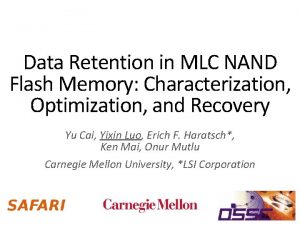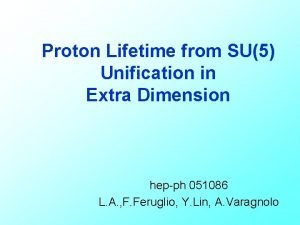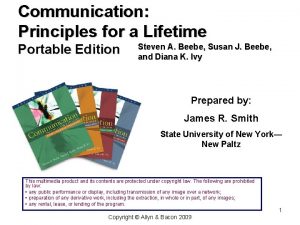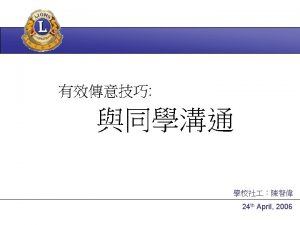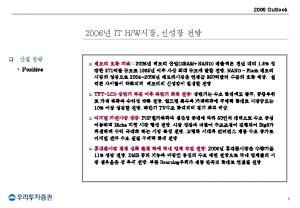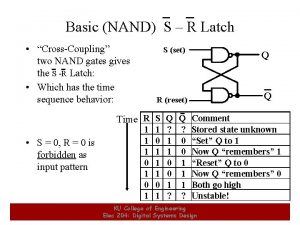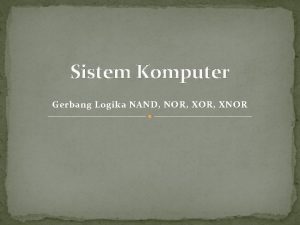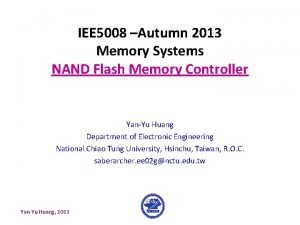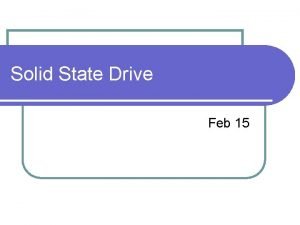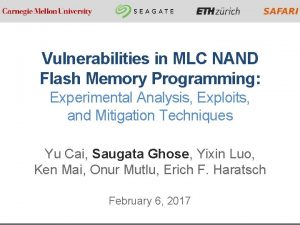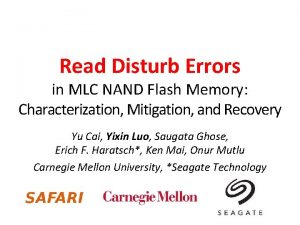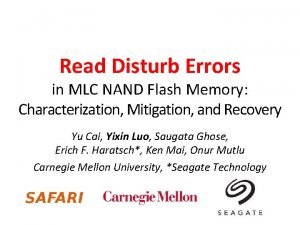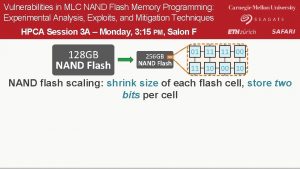WARM Improving NAND Flash Memory Lifetime with Writehotness



































- Slides: 35

WARM Improving NAND Flash Memory Lifetime with Write‐hotness Aware Retention Management Yixin Luo, Yu Cai, Saugata Ghose, Jongmoo Choi*, Onur Mutlu Carnegie Mellon University, *Dankook University 1

Executive Summary • Flash memory can achieve 50 x endurance improvement by relaxing retention time using refresh [Cai+ ICCD ’ 12] • Problem: Refresh consumes the majority of endurance improvement • Goal: Reduce refresh overhead to increase flash memory lifetime • Key Observation: Refresh is unnecessary for write-hot data • Key Ideas of Write-hotness Aware Retention Management (WARM) ‐ Physically partition write-hot pages and write-cold pages within the flash drive ‐ Apply different policies (garbage collection, wear-leveling, refresh) to each group • Key Results ‐ WARM w/o refresh improves lifetime by 3. 24 x ‐ WARM w/ adaptive refresh improves lifetime by 12. 9 x (1. 21 x over refresh only) 2

Outline • Problem and Goal • Key Observations • WARM: Write-hotness Aware Retention Management • Results • Conclusion 3

Outline • Problem and Goal • Key Observations • WARM: Write-hotness Aware Retention Management • Results • Conclusion 4

Retention Time Relaxation for Flash Memory • Flash memory has limited write endurance • Retention time significantly affects endurance Retention Time ‐ The duration for which flash memory correctly holds data Typical flash retention guarantee 3‐year 3000 3‐month 8000 3‐week 20000 Requires refresh to reach this 3‐day 150000 0 0 K 0 K Endurance (P/E Cycles) 0 K [Cai+ ICCD ’ 12] 5

NAND Flash Refresh • Flash Correct and Refresh (FCR), Adaptive Rate FCR (ARFCR) [Cai+ ICCD ‘ 12] 150000 3000 Nominal endurance Extended endurance Unusable endurance (consumed by refresh) Problem: Flash refresh operations reduce extended lifetime Goal: Reduce refresh overhead, improve flash lifetime 6

Outline • Problem and Goal • Key Observations • WARM: Write-hotness Aware Retention Management • Results • Conclusion 7

g w de ho v m GM es EA N ts us r w eb rs rc h st c sr z po on st e m fin ark an cia l pr oj pr xy pr n w hm eb ‐v m io % of Extended Endurance Consumed by Refresh Observation 1: Refresh Overhead is High 100% 90% 80% 70% 60% 50% 40% 30% 20% 10% 0% 53% 8

Observation 2: Write‐Hot Pages Can Skip Refresh Update Retention Effect Write‐Hot Invalid Page Write‐Cold Invalid Page Write‐Hot Invalid Page Write‐Cold Page Write‐Hot Page Skip Refresh Need Refresh 9

Conventional Write‐Hotness Oblivious Management Flash Memory Page 511 Page M Read Page M+1 Write Page M+2 …… …… Erase Page 256 1 Hot Page 257 4 Hot Page 258 2 Cold Page 3 Cold Page 4 …… …… 0 1 Hot. Page 1 2 Cold. Page 2 1 Hot. Page Cold Page 3 Hot Page 4 Cold Page 5 Page 255 4 Hot Page M+255 Unable to relax retention time for blocks with write‐hot and cold pages Flash Controller 10

Key Idea: Write‐Hotness Aware Management Flash Memory Page 511 Hot Page 4 Hot Page 1 Page M+1 Page M+2 …… …… Page 256 2 Cold Page 257 3 Cold Page 258 5 Cold Page …… …… 0 1 Hot. Page 1 1 Hot. Page 2 4 Hot. Page Hot Page 4 Hot Page 1 Hot Page 4 Page 255 1 Hot Page M+255 Can relax retention time for blocks with write‐hot pages only Flash Controller 11

Outline • Problem and Goal • Key Observations • WARM: Write-hotness Aware Retention Management • Results • Conclusion 12

WARM Overview • Design Goal: ‐ Relax retention time w/o refresh for write-hot data only • WARM: Write-hotness Aware Retention Management ‐ Write-hot/write-cold data partitioning algorithm ‐ Write-hotness aware flash policies • Partition write-hot and write-cold data into separate blocks • Skip refreshes for write-hot blocks • More efficient garbage collection and wear-leveling 13

Write‐Hot/Write‐Cold Data Partitioning Algorithm Cold Data ① TAIL Cold Virtual Queue …… HEAD 1. Initially, all data is cold and is stored in the cold virtual queue. 14

Write‐Hot/Write‐Cold Data Partitioning Algorithm Cold Data ① TAIL Cold Virtual Queue …… HEAD ② 2. On a write operation, the data is pushed to the tail of the cold virtual queue. 15

Write‐Hot/Write‐Cold Data Partitioning Algorithm Cold Data ① TAIL Cold Virtual Queue …… HEAD ② Recently‐written data is at the tail of cold virtual queue. 16

Write‐Hot/Write‐Cold Data Partitioning Algorithm Hot Data ④ Hot Virtual Queue TAIL Cold Data ① TAIL Cold Virtual Queue …… HEAD ② Hot Window ③ Cooldown Window 3, 4. On a write hit in the cooldown window, the data is promoted to the hot virtual queue. 17

Write‐Hot/Write‐Cold Data Partitioning Algorithm Hot Data ④ Hot Virtual Queue TAIL HEAD Cold Data ① TAIL Cold Virtual Queue …… HEAD ② Hot Window ③ Cooldown Window Data is sorted by write‐hotness in the hot virtual queue. 18

Write‐Hot/Write‐Cold Data Partitioning Algorithm Hot Data ④ Hot Virtual Queue HEAD TAIL Cold Data ① TAIL Cold Virtual Queue ⑤ Hot Window …… HEAD ② ③ Cooldown Window 5. On a write hit in hot virtual queue, the data is pushed to the tail. 19

Write‐Hot/Write‐Cold Data Partitioning Algorithm Hot Data ④ Hot Virtual Queue HEAD TAIL ⑥ Cold Data ① TAIL Cold Virtual Queue ⑤ Hot Window …… HEAD ② ③ Cooldown Window 6. Unmodified hot data will be demoted to the cold virtual queue. 20

Conventional Flash Management Policies • Flash Translation Layer (FTL) ‐ Map data to erased blocks ‐ Translate logical page number to physical page number • Garbage Collection ‐ Triggered before erasing a victim block ‐ Remap all valid data on the victim block • Wear-leveling ‐ Triggered to balance wear-level among blocks 21

Write‐Hotness Aware Flash Policies • Write‐hot data naturally relaxed retention time • Write‐cold data lower write frequency, less wear‐out • Program in block order • Garbage collect in block order • All blocks naturally wear‐leveled • Conventional garbage collection • Conventional wear‐leveling algorithm Block 11 Block 10 Block 9 Block 8 Block 7 Block 6 Block 4 Block 3 Block 2 Block 1 Block 0 Block 5 Flash Drive Cold Block Pool Hot Block Pool 22

Dynamically Sizing the Hot and Cold Block Pools All blocks are divided between the hot and cold block pools 1. Find the maximum hot pool size 2. Reduce hot virtual queue size to maximize cold pool lifetime 3. Size the cooldown window to minimize ping-ponging of data between the two pools 23

Outline • Problem and Goal • Key Observations • WARM: Write-hotness Aware Retention Management • Results • Conclusion 24

Methodology • Disk. Sim 4. 0 + SSD model Parameter Value Page read to register latency 25 μs Page write from register latency 200 μs Block erase latency 1. 5 ms Data bus latency 50 μs Page/block size 8 KB/1 MB Die/package size 8 GB/64 GB Total capacity 256 GB Over‐provisioning 15% Endurance for 3‐year retention time 3, 000 PEC Endurance for 3‐day retention time 150, 000 PEC 25

WARM Configurations • WARM-Only ‐ Relax retention time in hot block pool only ‐ No refresh needed • WARM+FCR ‐ First apply WARM-Only ‐ Then also relax retention time in cold block pool ‐ Refresh cold blocks every 3 days • WARM+ARFCR ‐ Relax retention time in both hot and cold block pools ‐ Adaptively increase the refresh frequency over time 26

Flash Lifetime Improvements Normalized Lifetime Improvement 16 14 WARM+FCR 30% 12. 9 x 12 WARM+ARFCR 21% 10 8 6 WARM‐Only 3. 24 x 4 2 0 Baseline WARM-Only FCR WARM+FCR ARFCR WARM+ARFCR 27

WARM‐Only Endurance Improvement Endurance 600% Cold pool Hot pool 500% 3. 58 x 400% 300% 200% 100% 0% e ark ial es vm m rn roj rxy ch n r h c m b‐ p p o m s p n z r io ost fina ho we p src stg ts r us v eb AN e wd w ME G 28

g w de ho v m GM es EA N ts us r w eb rs rc h st c sr m hm ‐v eb w FCR n 100% 90% 80% 70% 60% 50% 40% 30% 20% 10% 0% pr zo po ne st m fin ark an cia l pr oj pr xy io % of Refresh Writes WARM+FCR Refresh Operation Reduction WARM+FCR 53% 48% 29

v we GM b ea n wd e r us ts stg src pr xy rsr ch oj pr n pr hm po one stm a fin rk an cia ho l m we es b‐ vm ioz Normalized Avg. Resp. Time WARM Performance Impact Worst Case: < 6% 105% 104% 103% 102% 101% 100% 99% 98% Avg. Case: < 2% 30

Other Results in the Paper • Breakdown of write frequency into host writes, garbage collection writes, refresh writes in the hot and cold block pools ‐ WARM reduces refresh writes significantly while having low garbage collection overhead • Sensitivity to different capacity over-provisioning amounts ‐ WARM improves flash lifetime more as over-provisioning increases • Sensitivity to different refresh intervals ‐ WARM improves flash lifetime more as refresh frequency increases 31

Outline • Problem and Goal • Key Observations • WARM: Write-hotness Aware Retention Management • Results • Conclusion 32

Conclusion • Flash memory can achieve 50 x endurance improvement by relaxing retention time using refresh [Cai+ ICCD ’ 12] • Problem: Refresh consumes the majority of endurance improvement • Goal: Reduce refresh overhead to increase flash memory lifetime • Key Observation: Refresh is unnecessary for write-hot data • Key Ideas of Write-hotness Aware Retention Management (WARM) ‐ Physically partition write-hot pages and write-cold pages within the flash drive ‐ Apply different policies (garbage collection, wear-leveling, refresh) to each group • Key Results ‐ WARM w/o refresh improves lifetime by 3. 24 x ‐ WARM w/ adaptive refresh improves lifetime by 12. 9 x (1. 21 x over refresh only) 33

Other Work by SAFARI on Flash Memory • J. Meza, Q. Wu, S. Kumar, and O. Mutlu. A Large-Scale Study of Flash Memory Errors in the Field, SIGMETRICS 2015. • Y. Cai, Y. Luo, S. Ghose, E. F. Haratsch, K. Mai, O. Mutlu. Read Disturb Errors in MLC NAND Flash Memory: Characterization and Mitigation , DSN 2015. • Y. Cai, Y. Luo, E. F. Haratsch, K. Mai, O. Mutlu. Data Retention in MLC NAND Flash Memory: Characterization, Optimization and Recovery, HPCA 2015. • Y. Cai, G. Yalcin, O. Mutlu, E. F. Haratsch, O. Unsal, A. Cristal, K. Mai. Neighbor-Cell Assisted Error Correction for MLC NAND Flash Memories, SIGMETRICS 2014. • Y. Cai, O. Mutlu, E. F. Haratsch, K. Mai. Program Interference in MLC NAND Flash Memory: Characterization, Modeling, and Mitigation , ICCD 2013. • Y. Cai, G. Yalcin, O. Mutlu, E. F. Haratsch, A. Cristal, O. Unsal, K. Mai. Error Analysis and Retention-Aware Error Management for NAND Flash Memory, Intel Technology Jrnl. (ITJ), Vol. 17, No. 1, May 2013. • Y. Cai, E. F. Haratsch, O. Mutlu, K. Mai. Threshold Voltage Distribution in MLC NAND Flash Memory: Characterization, Analysis and Modeling, DATE 2013. • Y. Cai, G. Yalcin, O. Mutlu, E. F. Haratsch, A. Cristal, O. Unsal, K. Mai. Flash Correct-and-Refresh: Retention-Aware Error Management for Increased Flash Memory Lifetime, ICCD 2012. • Y. Cai, E. F. Haratsch, O. Mutlu, K. Mai. Error Patterns in MLC NAND Flash Memory: Measurement, Characterization, and Analysis, DATE 2012. 34

WARM Improving NAND Flash Memory Lifetime with Write‐hotness Aware Retention Management Yixin Luo, Yu Cai, Saugata Ghose, Jongmoo Choi*, Onur Mutlu Carnegie Mellon University, *Dankook University 35
 Flash memory lifetime
Flash memory lifetime Flash memory architecture
Flash memory architecture Characterize
Characterize Digital photography with flash and no-flash image pairs
Digital photography with flash and no-flash image pairs Memory-driven computing
Memory-driven computing Ememory
Ememory Toshiba flash 1980
Toshiba flash 1980 Nanoelectronics
Nanoelectronics Uil art memory flash cards
Uil art memory flash cards Internal memory and external memory
Internal memory and external memory Virtual memory in memory hierarchy consists of
Virtual memory in memory hierarchy consists of Semantic prototype
Semantic prototype Primary memory and secondary memory
Primary memory and secondary memory Eidetic memory vs iconic memory
Eidetic memory vs iconic memory Excplicit memory
Excplicit memory Which memory is the actual working memory?
Which memory is the actual working memory? Physical memory vs logical memory
Physical memory vs logical memory Shared vs distributed memory
Shared vs distributed memory Long term memory vs short term memory
Long term memory vs short term memory Virtual memory
Virtual memory Fitness chapter 1
Fitness chapter 1 Lifetime guarantee
Lifetime guarantee Slat trust diagram
Slat trust diagram Grats
Grats Thresholld
Thresholld Dardel ion exchange
Dardel ion exchange Stairway to lifetime fitness health and wellness
Stairway to lifetime fitness health and wellness Storage binding and lifetime
Storage binding and lifetime Starbucks customer acquisition cost
Starbucks customer acquisition cost Warren tuttle lifetime brands
Warren tuttle lifetime brands Lifetime networks
Lifetime networks Rent communication principles for a lifetime
Rent communication principles for a lifetime Paris in the spring once in a lifetime bird in the hand
Paris in the spring once in a lifetime bird in the hand Bath assessment active shooter
Bath assessment active shooter The capacity to change position and direction quickly
The capacity to change position and direction quickly Lifetime
Lifetime


